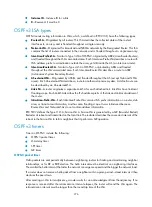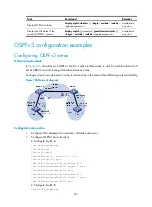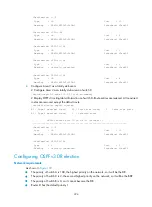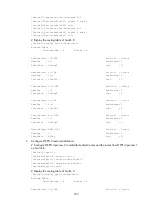
288
Step Command
Remarks
1.
Enter system view.
system-view
N/A
2.
Enter OSPFv3 view.
ospfv3
[
process-id
]
N/A
3.
Enable the GR Helper
capability.
graceful-restart helper enable
Optional.
Enabled by default.
4.
Enable strict LSA
checking.
graceful-restart helper
strict-lsa-checking
Optional.
Disabled by default.
Configuring BFD for OSPFv3
Bidirectional forwarding detection (BFD) provides a mechanism to quickly detect the connectivity of links
between OSPFv3 neighbors, thus to improve the convergence speed of OSPFv3. For more information
about BFD, see
High Availability Configuration Guide
.
After discovering neighbors by sending hello packets, OSPFv3 notifies BFD of the neighbor addresses,
and BFD uses these addresses to establish sessions. Before a BFD session is established, it is in the down
state. In this state, BFD control packets are sent at an interval of no less than one second to reduce BFD
control packet traffic. After the BFD session is established, BFD control packets are sent at the negotiated
interval, thereby implementing fast fault detection.
To configure BFD for OSPFv3, you need to configure OSPFv3 first.
To configure BFD for OSPFv3:
Step Command
Remarks
1.
Enter system view.
system-view
N/A
2.
Enter OSPFv3 view.
ospfv3
[
process-id
]
N/A
3.
Specify a router ID.
router-id
router-id
N/A
4.
Quit the OSPFv3 view.
quit
N/A
5.
Enter interface view.
interface
interface-type
interface-number
N/A
6.
Enable an OSPFv3 process
on the interface.
ospfv3
process-id
area
area-id
[
instance
instance-id
]
Not enabled by default.
7.
Enable BFD on the interface.
ospfv3 bfd enable
[
instance
instance-id
]
Not enabled by default.
Applying IPsec policies for OSPFv3
To protect routing information and defend attacks, OSPFv3 can authenticate protocol packets by using
an IPsec policy.
Outbound OSPFv3 packets carry the Security Parameter Index (SPI) defined in the relevant IPsec policy.
A device uses the SPI carried in a received packet to match against the configured IPsec policy. If they
match, the device accepts the packet; otherwise, it discards the packet and will not establish a neighbor
relationship with the sending device.
You can configure an IPsec policy for an area, an interface or a virtual link.
















































